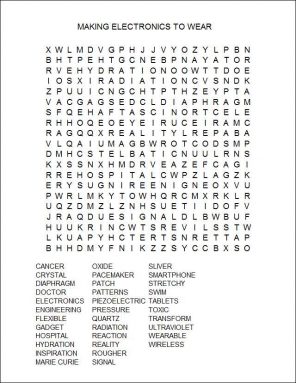Cool Jobs: Making electronics to wear
Meet the researchers who are pushing the boundaries of electronic devices
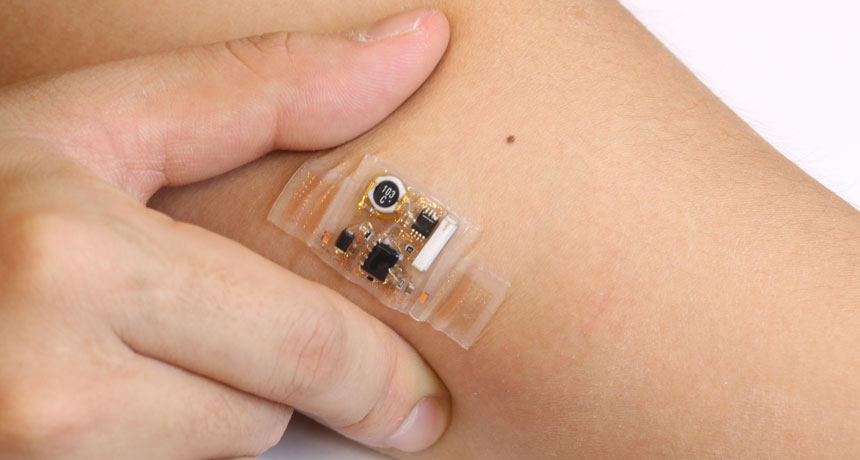
Stretchy electronic devices may make it possible for patients to monitor their health at home. John Rogers at the University of Illinois helped develop this elastic device that sticks to the skin.
University of Illinois
Could keeping track of your health be as easy as wearing a temporary tattoo? Materials scientist John Rogers thinks so.
In his lab at the University of Illinois at Champaign-Urbana, Rogers and his team design electronic devices unlike anything in an Apple store. Their inventions hardly look like electronics at all. Most electronics are boxy, fragile things that have to be handled with care. For a tablet or a cell phone, a minor accident, like spilling water, can quickly turn catastrophic.
But the inventions from Rogers’ lab are more like high-tech stickers. These adhesive patches, crisscrossed with miniature wires, stick to the skin for weeks at a time. They can survive the wear and tear of life. Already, the scientists have programmed the devices to take a wide variety of measurements. These include temperature, blood pressure and skin moisture levels (or hydration). Rogers says he wants his sensors to look more like parts of living organisms and less like traditional computers.
“We’re driving the technology by thinking outside the box,” he says.
Stretchy, wearable electronics interest researchers from a variety of fields. Rogers is a materials scientist, which means he looks for smart ways to use, understand and even create the materials used to build things.
Developing these devices is appealing, says Rogers, because it has the potential to improve health care. Instead of trudging to the clinic or hospital for every checkup, a patient might be able to download data from a stick-on device and send it to the hospital. This technology offers the potential for more measurements and fewer trips to the doctor.
Here, Rogers and two other researchers who work on stretchy electronics describe these skin-like devices — as well as what their future may hold.
How to harvest energy from the body
As a young girl growing up in Turkey, Canan Dagdeviren received a book about the scientist Marie Curie from her father. Curie was the first woman to win a Nobel prize, one of the highest honors given to a scientist. (Curie actually won two.)
“I think my dad was thinking I would get inspiration from her,” recalls Dagdeviren, who does research on wearable electronics at Harvard University and MIT, both in Cambridge, Mass. “But when I read the book, I fell in love with her husband because he discovered the piezoelectric effect.”

In the late 19th century, French scientist Pierre Curie and his brother Jacques
that some crystals generate sparks when they’re under pressure. Sparks mean electricity. So piezoelectric crystals turn mechanical energy, which comes from motion, into electricity. Scientists have looked to piezoelectric materials in recent years as a potential power source for wearable electronics.
Dagdeviren suspects piezoelectric materials could capture energy from movement in the human body. Even at rest, the body is constantly in motion. Lungs expand and contract as you breathe. The heart beats. Blood streams through your veins and arteries. All of these are examples of mechanical energy, or the energy associated with motion, location or both.
As a graduate student, Dagdeviren studied with John Rogers in Illinois. She designed devices that could be used inside the body. Her inventions converted the movements of the lungs, heart and diaphragm into electricity. This technology might one day provide power to devices like pacemakers, which help the heart keep up a steady rhythm. Right now, pacemakers need batteries that have to be replaced every five to 10 years. Dagdeviren’s system wouldn’t need batteries.
“You can generate power, and use this power to run your personal electronics,” she says.
Dagdeviren was inspired to create the devices after learning that her grandfather died from heart failure. He had been only 28 years old. “I promised to do something to work on that,” she says. “Scientists are usually inspired by nature. However, my research is inspired by the diseases of my family members.”
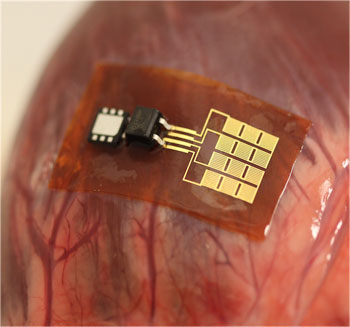
Three years ago, her aunt died of a brain tumor. Now, Dagdeviren is building a sensor that can be implanted in the brain to detect — and perhaps even fix — problems with cells there.
“I remember how much I loved my aunt and the great time we spent together. I don’t want any other people to experience those kinds of moments.”
Wearable, flexible electronics could make it possible to constantly monitor the body. Usually, we take measurements like temperature or blood pressure at a single moment in time. But that snapshot may not tell the whole story. If a person is wearing a sensor, a doctor can study a stream of data and look for patterns.
“Our organs and our bodies speak to us,” Dagdeviren says. “I use my devices to understand what they’re saying.”
Watching the sun
Madhu Bhaskaran works at RMIT University in Melbourne, Australia. Her projects are also advancing the next generation of flexible electronics. In recent years, she and her colleagues have developed new ways to add gizmos that conduct electricity to stretchy materials. They’ve been studying different kinds of oxide materials, which get their name from the fact that they contain oxygen.

“All electronic devices rely on oxide materials,” she notes. Silicon dioxide is one example. In nature, this material is found as sand. Scientists can create large crystals of silicon dioxide, called quartz. Thin slivers of quartz are often used in tiny electronic devices. Recently, a team in Bhaskaran’s lab, led by scientist Philipp Gutruf, found a way to transfer those slices of crystal to flexible materials. Their process resulted in a skin-like, flexible device using zinc oxide that could save lives.
This wearable, stretchy device detects danger at the skin. It picks up the chemical signal of toxic gases. It also measures ultraviolet (UV) radiation, invisible energy that damages the skin and can cause skin cancer. The sun produces UV radiation, so people who spend a lot of time outdoors should pay close attention to protecting their skin. The device can help people avoid dangerous levels of UV radiation.
The sensor’s design allows it to bend and flex as a person moves. Bhaskaran says their device can bend thanks to “microtectonics.”
“Microtectonics behave just like tectonic plates that make up the earth’s crust,” she says. “They can slide over each other when stretched. This type of surface allows the device to stretch and bend while still functioning.” That means it can be stuck directly to the skin with an adhesive, or stitched onto clothes.
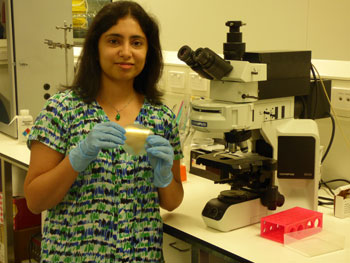
Companies have talked to the scientists about selling the device, but Bhaskaran says consumers won’t see it in stores for at least five years. She says she’s excited to see what other new stretchy electronics emerge during that time.
“Scientists expect to transform today’s science fiction into tomorrow’s reality,” she says.
Beyond skin deep
John Rogers, in Illinois, has been studying and developing stretchy electronics for more than 15 years. But this summer, he broke a record. And he did it while on vacation in Florida. He had been wearing one of his devices on his arm, stuck on like a patch. He wasn’t measuring anything in particular, but he did make sure it could send signals to his cell phone. Rogers’ goal was to see how long it would remain stuck to his arm.
Finally, after a swim in the ocean, the device lost its stickiness like an old Band-Aid. It had been on for four weeks. No one in his lab had ever worn one of the gadgets for such a long time.
“I wear them all the time,” says Rogers. “I think most of the students like to wear them. If you do this kind stuff, you have to get into it. There’s nothing that beats your own experience.”
After the device came off, he noticed changes in his skin. “You could feel with your fingers where it had had been. It was noticeably rougher than the surrounding skin.” At first, he worried that he’d had some type of bad reaction. Then, he realized that the rough patch was where dead skin cells had built up. He removed them with a piece of Scotch tape.
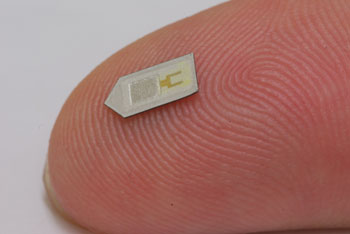
“Experiencing that for yourself is an important part of the engineering process,” he says.
Right now, his skin sensors are able to make a wide variety of measurements. They can measure temperature, skin stiffness, hydration, and other qualities. But he’s not content to stop there.
“How do you go beyond that?” he asks. You just push the field forward.
He and his team are now creating skin-like devices to sample fluids like sweat or blood for medical tests. They’re also designing stretchy devices that dissolve over time. He and his team unveiled one of those in mid-January. They designed a device that measures pressure and temperature inside the human brain for peoplewho have suffered a traumatic brain injury. Once it has done its job, the sensor dissolves in cerebrospinal fluid.
Doctors might use other, similar devices inside the body to monitor how a transplanted organ responds to a new host, for example. Environmental scientists might use them to track the changes in a sensitive ecosystem.
Earlier this year, Rogers and his team developed wearable devices for hard surfaces, like fingernails or teeth. These gadgets could collect health data, he says. But they can also send and receive wireless signals, like cell phones. Some smartphones can even be used to make payments like a credit card, simply by swiping them across a sensor. So imagine this: One day, instead of using a card or cash, you might pay using a small chip mounted onto your teeth. No more swiping a card; you’d only have to smile.
Rogers says the scientists in his lab are people eager to use science to solve problems.
“They’re inspired by the implications of science around new technology,” he says. “Filling up journals with new science is great. But if it never goes beyond that, it’s not very satisfying. I think it’s important to get things out into the real world.”
This is one in a series on careers in science, technology, engineering and mathematics made possible with generous support from Alcoa Foundation.
Power Words
(for more about Power Words, click here)
conductor (in physics and engineering) A material through which an electrical current can flow.
diaphragm A thin, flexible wall or partition. (in biology) The muscular wall in mammals that separates the thorax from the abdomen. In breathing, its contractions open up the thorax, inflating the lungs.
ecosystem A group of interacting living organisms — including microorganisms, plants and animals — and their physical environment within a particular climate. Examples include tropical reefs, rainforests, alpine meadows and polar tundra.
electromagnetic radiation Energy that travels as a wave, including forms of light. Electromagnetic radiation is typically classified by its wavelength. The spectrum of electromagnetic radiation ranges from radio waves to gamma rays. It also includes microwaves and visible light.
electronics Devices that are powered by electricity but whose properties are controlled by the semiconductors or other circuitry that channel or gate the movement of electric charges.
engineering The field of research that uses math and science to solve practical problems.
environmental science The study of ecosystems to help identify environmental problems and possible solutions. Environmental science can bring together many fields including physics, chemistry, biology and oceanography to understand how ecosystems function and how humans can coexist with them in harmony.
generation A group of individuals born about the same time or that are regarded as a single group. Your parents belong to one generation of your family, for example, and your grandparents to another. Similarly, you and everyone within a few years of your age across the planet -are referred to as belonging to a particular generation of humans. The term is sometimes extended to inanimate objects, such as electronics or automobiles.
hydrate (noun: hydration) To restore the proper level of fluids in the body.
materials science The study of how the atomic and molecular structure of a material is related to its overall properties. Materials scientists can design new materials or analyze existing ones. Their analyses of a material’s overall properties (such as density, strength and melting point) can help engineers and other researchers select materials that best suited to a new application.
mechanical Having to do with the devices that move, including tools, engines and other machines (even, potentially, living machines); or something caused by the physical movement of another thing (such as a “mechanical” itch).
organ (in biology) Various parts of an organism that perform one or more particular functions. For instance, an ovary is an organ that makes eggs, the brain is an organ that interprets nerve signals and a plant’s roots are organs that take in nutrients and moisture.
oxide A compound made by combining one or more elements with oxygen. Rust is an oxide; so is water.
piezoelectricity An electric discharge, often as a result of subtly deforming a crystal or crystalline material.
quartz A type of mineral made from silicon dioxide. The most common mineral on Earth, it can occur in any rock type: igneous, metamorphic or sedimentary.
radiation (in physics) One of the three major ways that energy is transferred. (The other two are conduction and convection.) In radiation, electromagnetic waves carry energy from one place to another. Unlike conduction and convection, which need material to help transfer the energy, radiation can transfer energy across empty space.
sensor A device that picks up information on physical or chemical conditions — such as temperature, barometric pressure, salinity, humidity, pH, light intensity or radiation — and stores or broadcasts that information. Scientists and engineers often rely on sensors to inform them of conditions that may change over time or that exist far from where a researcher can measure them directly.
silica A mineral, also known as silicon dioxide, containing silicon and oxygen atoms. It is a basic building block of much of the rocky material on Earth and of some construction materials, including glass.
smartphone A cell (or mobile) phone that can perform a host of functions, including search for information on the Internet.
tectonic plates The gigantic slabs — some spanning thousands of kilometers (or miles) across — that make up Earth’s outer layer.
toxic Poisonous or able to harm or kill cells, tissues or whole organisms. The measure of risk posed by such a poison is its toxicity.
transplant (in medicine) The replacement of a tissue or an organ with that from another organism. It is also a term for the material that will be transplanted.
ultraviolet A portion of the light spectrum that is close to violet but invisible to the human eye.
zinc oxide A chemical — with the formula ZnO — made when one atom of zinc bonds to an atom of oxygen. Its reflective properties make it useful in a range of products, from paints to sunscreens. Its germ-killing properties make it useful in some medicines or cosmetics. It can even be used as a source of the mineral zinc in foods.
Word Find (click here to enlarge for printing)
